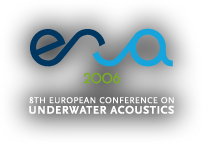

C. Soares and S.M. Jesus csoares@ualg.pt and sjesus@ualg.pt
SiPLAB-FCT, Universidade do Algarve
8005-139 Faro, Portugal
Comments: download pdf
file .
Ref.: Proc. European Conference on Underwater
Acoustics, ECUA'2006,
(ISBN:), p., Carvoeiro,Portugal, June 2006.
Abstract : The Acoustic Oceanographic Buoy (AOB) is a light
acoustic receiving
device that is being developed in the framework of a joint research
project and tested during the Maritime Rapid Environmental Assessment
(MREA) sea trials. One of the AOB's application is in Matched-Field
Tomography (MFT) while a reduced number of receivers is available in
opposition to traditional systems used in tomography. One problem of
chief importance in MFT is the degree of uniqueness of
the problem's solution which is highly dependent on the number of
receivers and the number of free parameters. This paper studies the
possibility of using matched-field processors
with reduced ambiguity levels in comparison to conventional processors
with application to acoustic data collected during the MREA sea trials.
Two aspects are investigated: (a) the choice of an explicit broadband
data model, where the exploitation of the spectral coherence of the
acoustic field is seen as a mean to reduce the ambiguity level of the
cost function used in the optimization; (b) conventional and
high-resolution methods based on the proposed broadband model are
implemented and compared. The signal component is a priori assumed to
be random, and is characterized by second-order statistics with aid of
an eigen-analysis, e.g., an information criteria. This aims at
splitting the data into signal and noise subspaces for subsequent
estimation of the emitted signal.
ACKNOWLEDGMENT: this work was partially supported by FCT fellowship and projects NUACE - POSI/CPS/47824/2002 and RADAR - POCTI/CTA/47719/2002.